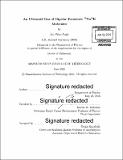An ultracold gas of dipolar fermionic ²³Na⁴⁰K molecules
Author(s)
Park, Jee Woo
DownloadFull printable version (34.03Mb)
Other Contributors
Massachusetts Institute of Technology. Department of Physics.
Advisor
Martin W. Zwierlein.
Terms of use
Metadata
Show full item recordAbstract
In this thesis, I present my work on creating ultracold dipolar molecules of ²³Na⁴⁰K in the singlet rovibrational ground state. These fermionic molecules have a large permanent electric dipole moment of 2.72 Debye, and are chemically stable against inelastic dimer-dimer reactions. A quantum gas of these molecules have potential applications in quantum simulation of novel dipolar many-body physics, creation of dipolar quantum matter, precision measurements of fundamental constants, and quantum information processing. The work starts with the creation of a new Bose-Fermi mixture of ²³Na and ⁴⁰K, and a systematic study of Feshbach resonances between the two atomic species. The study reveals more than 20 resonances in the s- and p-wave collision channels, and many of the s-wave resonances are exceptionally broad. Using two distinct s-wave resonances, we create loosely bound Feshbach molecules of ²³Na⁴⁰K, which serve as a stepping stone for the creation of more deeply bound molecules. To transfer Feshbach molecules to the singlet rovibrational ground state, molecular spectroscopy is performed in search of a suitable two-photon pathway. We find two excited molecular states with with strong coupling to the Feshbach molecular state and the singlet rovibrational ground state. One of the two pathways is used to create ²³Na⁴⁰K singlet rovibrational ground state molecules by stimulated Raman adiabatic passage (STIRAP). The created molecular gas has T/TF ~~ 2.0, and exhibits trap lifetimes longer than 2.5 seconds, highlighting NaK's chemical stability. Coherent microwave control of rotational and hyperfine states of ²³Na⁴⁰K ground state molecules is demonstrated. In particular, we observe long coherence times of the molecular sample approaching one second in a superposition of two hyperfine levels in the singlet rovibrational ground state. The long coherence time allows precision spectroscopy of the molecular gas, which we use to detect Hz-level shifts between the hyperfine levels.
Description
Thesis: Ph. D., Massachusetts Institute of Technology, Department of Physics, 2016. Cataloged from PDF version of thesis. Includes bibliographical references (pages 190-202).
Date issued
2016Department
Massachusetts Institute of Technology. Department of PhysicsPublisher
Massachusetts Institute of Technology
Keywords
Physics.